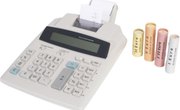
When examining data on a graph or reading facts and figures from a newspaper, it’s important you understand the difference between percent and percentage point. Both terms are used to describe the relationship between two sets of data. However, percent refers to the rate of change, whereas percentage point measures the actual amount of change.
What Percent Change Is
A percent is a ratio used to describe the relationship between two sets of numbers. It’s determined by dividing the rate of change by the new value, multiplying the result by 100, and adding a percentage sign to the result. For example, if 40 percent of adults smoked cigarettes in 2004 and 60 percent of adults smoked cigarettes in 2014, then to determine the percent change, we would divide 20 -- 60 minus 40 -- by 60 -- the original amount -- and multiply the result by 100. The percent change would therefore be 33 percent. This means that since 2004, the number of adults who smoke has increased by a rate of 33 percent.
What Percentage Point Is
You obtain a percentage point by subtracting old data from new data. For instance, if 40 percent of adults smoked cigarettes in 2004 and 60 percent of adults smoked cigarettes in 2014, then the percent change could be found by subtracting 40 percent from 60 percent, which would give us 20 percent. We could say that the number of adults who smoke cigarettes has risen by an amount equivalent to 20 percentage points.
The Difference Between Percent and Percentage Point
The difference between a percent and a percentage point is related to ambiguity, which is why it's important you use the correct term. If you were to say that the number of adult smokers increased by 5 percent from an original value of 20 percent, you would be saying that the current estimate of smokers is at 21 percent. If you said it increased by 5 percentage points, however, then the final value would be 25 percent.
Why This Can Be Tricky
The difference between a percent and a percentage point isn't commonly known, so writers sometimes use it to deceive their audience. For instance, when President George W. Bush proposed partially privatizing Social Security in 2004, some commentators said that only "2 percent" of the average American's Social Security taxes would be funneled into private accounts. That was a misleading statement, said another commentator, John Allen Paulos on ABC News. He looked at the numbers and said the writers meant that the average person's income taxes directed toward Social Security would drop from 6.2 to 4.2 percent, which is a change of 2 percentage points. The actual percent change, he said, was 32 percent.
About the Author
Vivek Saxena has been a full-time freelance writer since 2004, contributing to several online publications. Prior to becoming a writer, Saxena studied computer technology at Purdue University.
